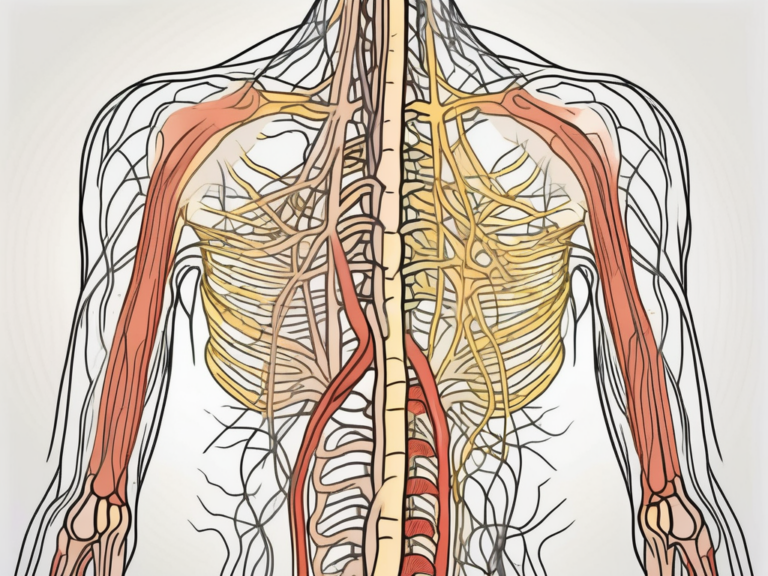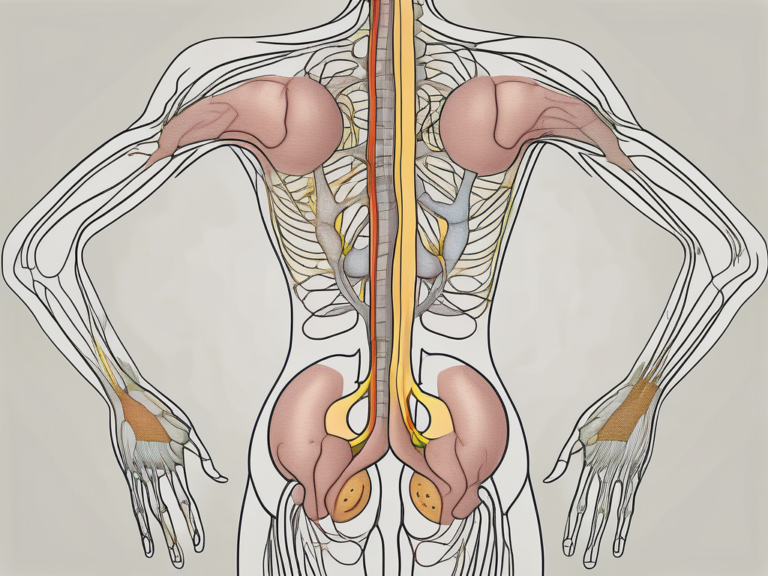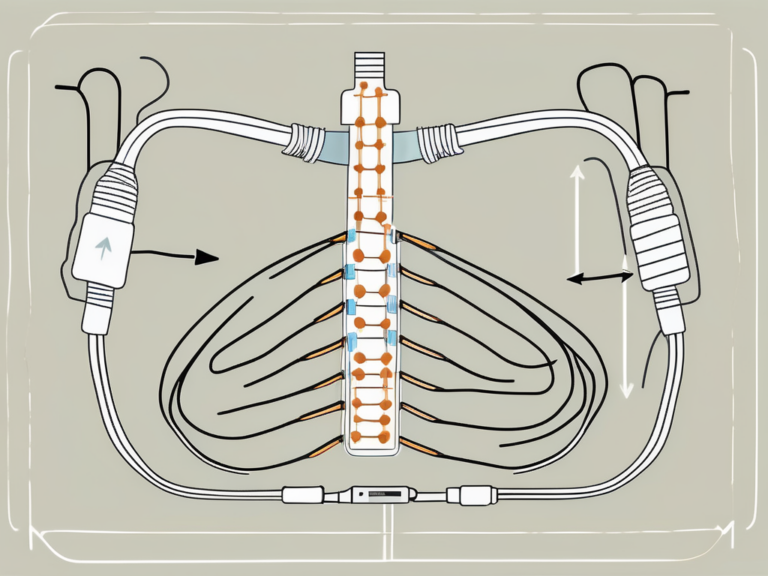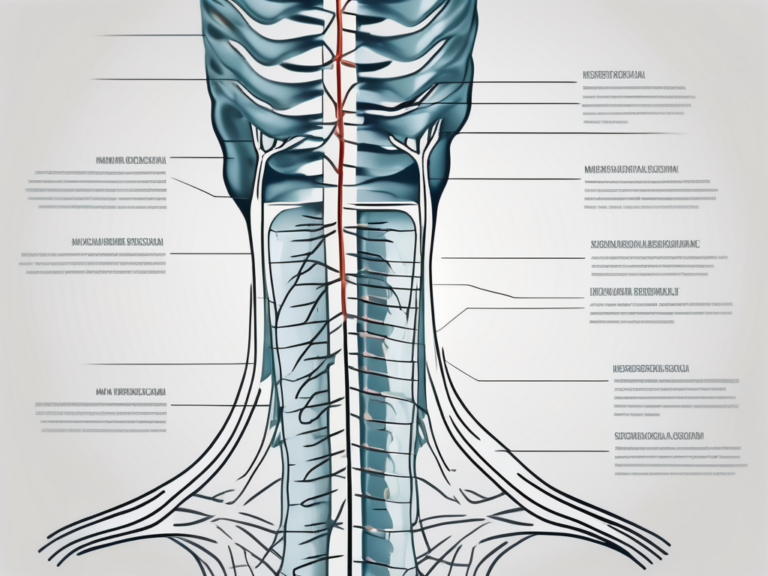The Pathway of Sacral Preganglionic Parasympathetics: Unveiling the Nerve Travel Route
The pathway of sacral preganglionic parasympathetics plays a crucial role in the functioning of the nervous system. Understanding this pathway and how it contributes to various neurological disorders is of utmost importance in the field of medicine. In this article, we will delve into the intricate details of this nerve travel route, the anatomy involved, and the implications it holds for future research and potential therapeutic approaches.
Understanding Sacral Preganglionic Parasympathetics
Before we explore the route of the sacral preganglionic parasympathetics, let’s first grasp the definition and function of these vital components within the nervous system.
The sacral preganglionic parasympathetics are a group of specialized nerve fibers that originate from the sacral region of the spinal cord. They form a crucial part of the autonomic nervous system, responsible for regulating various bodily functions such as digestion, sexual response, and the control of urinary and bowel functions.
These parasympathetic fibers primarily serve to transmit signals from the central nervous system to the ganglia, which are clusters of nerve cells located outside the spinal cord. From the ganglia, signals are then relayed to target organs, where they facilitate the appropriate physiological responses.
The sacral preganglionic parasympathetics play a vital role in maintaining homeostasis within the body. Their intricate network connects the central nervous system with various vital organs, ensuring proper regulation and coordination of physiological processes.
For example, when it comes to digestion, the sacral preganglionic parasympathetics are responsible for stimulating the secretion of digestive enzymes and increasing blood flow to the gastrointestinal tract. This helps in the breakdown and absorption of nutrients, ensuring optimal digestion.
In terms of sexual response, these nerve fibers play a crucial role in the process of arousal and orgasm. They are responsible for the relaxation of smooth muscles in the genital area, allowing for increased blood flow and engorgement of erectile tissues.
Furthermore, the sacral preganglionic parasympathetics are involved in the control of urinary and bowel functions. They help in the coordination of bladder contractions and relaxation of the internal and external sphincters, allowing for proper voiding of urine. Similarly, they aid in the regulation of bowel movements, ensuring the smooth passage of feces through the gastrointestinal tract.
Any disruption or malfunction of this pathway can lead to a range of neurological disorders and dysfunctions, impacting an individual’s quality of life. Conditions such as urinary incontinence, erectile dysfunction, and gastrointestinal motility disorders can arise when the sacral preganglionic parasympathetics are not functioning properly.
It is essential to study and understand this pathway in order to devise effective therapeutic interventions. Researchers and medical professionals are constantly exploring ways to modulate the activity of these nerve fibers to treat various conditions and improve patient outcomes.
The Anatomy of the Nerve Travel Route
Now, let’s take a closer look at the anatomy of the nerve travel route encompassed by the sacral preganglionic parasympathetics.
The sacral preganglionic parasympathetics start their journey from the sacral part of the spinal cord, specifically from the S2 to S4 segments. These nerve fibers emerge and form a network known as the sacral parasympathetic plexus, where they intermingle and intertwine with other nerves of the sacral region.
Within the sacral parasympathetic plexus, the nerve fibers are like a bustling city with countless intersections and pathways. They communicate and exchange information with neighboring nerves, creating a complex web of connections. This intricate network allows for efficient coordination and control of the parasympathetic functions in the sacral region.
From this complex plexus, the nerve fibers extend and venture outwards, disseminating their specialized signals to specific target destinations in the body.
As the sacral preganglionic parasympathetics embark on their journey, they navigate alongside other nerves, such as the pelvic splanchnic nerves. These nerves intertwine and form intricate networks, resembling a delicate dance of communication and coordination.
Imagine these nerve fibers as explorers, charting their course through the vast landscape of the body. They traverse through tissues, muscles, and organs, following a carefully orchestrated path towards their respective destinations.
The Course and Termination of the Nerve Pathway
The nerve pathway of sacral preganglionic parasympathetics can be well understood by tracing their course from the sacral parasympathetic plexus to their target organs.
These nerve fibers often travel alongside other nerves such as the pelvic splanchnic nerves, forming intricate intertwining networks. As they leave the sacral parasympathetic plexus, they make their way towards various target organs, including the bladder, rectum, and reproductive organs.
As the nerve fibers approach their target organs, they encounter a whole new environment. Each organ has its own unique structure and function, requiring precise control and regulation. The sacral preganglionic parasympathetics adapt to these diverse environments, ensuring that the organs receive the appropriate signals for optimal performance.
Upon reaching their respective destinations, the sacral preganglionic parasympathetics synapse with postganglionic parasympathetic neurons located in the target organs. This synaptic connection facilitates the transmission of signals and ultimately controls the physiological responses required for proper organ function.
Think of this synaptic connection as a bridge between the nerve fibers and the target organs. It allows for seamless communication, ensuring that the parasympathetic signals are relayed accurately and efficiently.
Within the target organs, the sacral preganglionic parasympathetics play a vital role in maintaining homeostasis. They regulate various processes, such as bladder control, bowel movements, and sexual function. Their intricate network of communication and coordination ensures that these essential functions are carried out smoothly and harmoniously.
Understanding the anatomy of the nerve travel route of sacral preganglionic parasympathetics provides us with a glimpse into the intricate workings of the body. It highlights the remarkable complexity and interconnectedness of our nervous system, showcasing the incredible design that allows us to function and thrive.
Unveiling the Pathway: A Detailed Look
Now, let us dive deep into the exploration of the pathway by examining the role of neuroimaging techniques and the challenges faced in mapping the sacral preganglionic parasympathetics.
The Role of Neuroimaging in Tracing the Pathway
Modern neuroimaging techniques, such as MRI (Magnetic Resonance Imaging) and fMRI (functional Magnetic Resonance Imaging), provide invaluable tools for visualizing and mapping the complex pathways within the human body, including the sacral preganglionic parasympathetics.
With the help of these non-invasive imaging methods, researchers can delve into the intricate details of the pathway, uncovering its hidden secrets. MRI, for instance, utilizes a strong magnetic field and radio waves to generate detailed images of the body’s internal structures. By capturing high-resolution images, it enables scientists to examine the sacral preganglionic parasympathetics in great detail, revealing their precise location and connections.
On the other hand, fMRI takes neuroimaging a step further by measuring the changes in blood flow and oxygenation levels in the brain. This technique allows researchers to not only visualize the pathway but also understand its functional connectivity. By analyzing the patterns of neural activity, scientists can gain insights into how the sacral preganglionic parasympathetics contribute to various bodily functions and regulatory processes.
Challenges in Mapping the Sacral Preganglionic Parasympathetics
Despite the advancements in neuroimaging, mapping the sacral preganglionic parasympathetics remains a challenging task. The small size of these nerve fibers and their intertwined nature with other nerves pose significant obstacles in accurately delineating their entire course and termination points.
Imagine trying to untangle a complex web of threads, each one intricately woven with the others. This is the kind of challenge researchers face when attempting to map the sacral preganglionic parasympathetics. These delicate nerve fibers, with their intricate connections, require meticulous attention to detail and advanced imaging techniques to be fully understood.
Furthermore, individual anatomical variations add another layer of complexity to the mapping process. Each person’s body is unique, and the exact path and distribution of the sacral preganglionic parasympathetics may vary from one individual to another. This variability makes it even more challenging to establish a universal map of the pathway.
However, despite these obstacles, researchers remain determined to overcome them. They continue to refine imaging techniques, develop innovative approaches, and collaborate across disciplines to unravel the mysteries of the sacral preganglionic parasympathetics. By doing so, they strive to establish a more comprehensive understanding of this nerve travel route and its significance in human physiology.
Implications for Neurological Disorders
Now, let’s explore the implications that the pathway of sacral preganglionic parasympathetics has in the emergence and management of various neurological disorders.
How the Pathway Affects Neurological Function
The disruption or dysfunction of the sacral preganglionic parasympathetics can lead to significant impairments in neurological function. Disorders such as urinary incontinence, fecal incontinence, and sexual dysfunction are frequently associated with abnormalities in this nerve pathway.
Urinary incontinence, a condition characterized by the involuntary leakage of urine, can greatly impact an individual’s quality of life. It can lead to embarrassment, social isolation, and a decreased sense of self-esteem. The sacral preganglionic parasympathetics play a crucial role in controlling the bladder’s detrusor muscle, which is responsible for the contraction and relaxation necessary for proper urine storage and elimination. When this pathway is disrupted, the coordination between the detrusor muscle and the external urethral sphincter is compromised, leading to urinary incontinence.
Fecal incontinence, on the other hand, refers to the inability to control bowel movements, resulting in the involuntary passage of stool. The sacral preganglionic parasympathetics are involved in the regulation of the internal and external anal sphincters, which are responsible for maintaining continence. When this pathway is impaired, the coordination between these sphincters is disrupted, leading to fecal incontinence. Individuals with this condition often experience feelings of shame, isolation, and a decreased quality of life.
Sexual dysfunction, including erectile dysfunction and anorgasmia, can also be linked to abnormalities in the sacral preganglionic parasympathetics. These nerves play a crucial role in the regulation of blood flow to the genital area and the coordination of sexual responses. When this pathway is affected, it can result in difficulties achieving or maintaining an erection, reduced sexual desire, and an inability to reach orgasm. These issues can have a significant impact on an individual’s intimate relationships and overall well-being.
A better understanding of the pathway’s role in these disorders enables healthcare providers to develop more targeted and effective treatment strategies. It is crucial for individuals experiencing these symptoms to consult with a medical professional to discuss their specific condition and receive appropriate care.
Potential Therapeutic Approaches Targeting the Pathway
Advancements in targeted therapies hold promise for individuals suffering from sacral preganglionic parasympathetic-related disorders. Emerging treatment options, such as nerve stimulation techniques and pharmacological interventions, aim to restore or modulate the function of this pathway, alleviating the associated neurological symptoms.
Nerve stimulation techniques, such as sacral neuromodulation, involve the implantation of a device that delivers electrical impulses to the sacral nerves. These impulses help regulate the activity of the sacral preganglionic parasympathetics, improving bladder and bowel control, as well as sexual function. This non-invasive approach has shown promising results in reducing the frequency and severity of symptoms in individuals with neurological disorders related to this pathway.
Pharmacological interventions, on the other hand, involve the use of medications that target specific receptors or pathways involved in the sacral preganglionic parasympathetics. These medications can help restore the balance of neurotransmitters and modulate the function of the pathway. By doing so, they can alleviate symptoms such as urinary incontinence, fecal incontinence, and sexual dysfunction. However, it is important to note that the use of medications should always be supervised by a qualified healthcare professional to ensure safety and effectiveness.
While these therapies show promising outcomes, it is crucial to consult with a qualified healthcare professional to determine the most suitable treatment plan based on an individual’s specific needs and medical history. Each person’s condition is unique, and a personalized approach is necessary to achieve the best possible outcomes.
Future Directions in Research
Looking ahead, several exciting avenues of research aim to further enhance our understanding of the sacral preganglionic parasympathetics and their implications for neurological function.
Emerging Techniques for Studying the Nerve Pathway
Ongoing advancements in neuroscientific research continue to introduce innovative techniques for studying the intricate details of the sacral preganglionic parasympathetics. These include novel imaging methodologies, such as diffusion tensor imaging (DTI) and functional connectivity analysis, which shed light on the structural and functional aspects of this pathway.
Moreover, advancements in molecular genetics and neurophysiological studies promise to unlock further insights into the molecular mechanisms and signaling pathways associated with these vital nerve fibers.
For instance, recent studies have shown that the sacral preganglionic parasympathetics play a crucial role in regulating bladder function. By utilizing advanced imaging techniques, researchers have been able to map out the neural circuitry responsible for controlling the detrusor muscle, which contracts to facilitate urine expulsion. This newfound understanding has paved the way for potential therapeutic interventions targeting this pathway to treat conditions such as overactive bladder and urinary incontinence.
In addition to imaging techniques, emerging technologies like optogenetics offer exciting possibilities for studying the sacral preganglionic parasympathetics. By using light to selectively activate or inhibit specific neurons along the pathway, researchers can gain a deeper understanding of the neural circuitry and its role in various physiological processes.
Predicted Advances in Understanding Sacral Preganglionic Parasympathetics
As technology continues to progress and research in this field expands, we anticipate significant breakthroughs in our understanding of the sacral preganglionic parasympathetics. These may include clearer delineation of the nerve pathway, identification of potential biomarkers for diagnoses, and the development of more targeted therapeutic interventions.
One area of particular interest is the potential link between the sacral preganglionic parasympathetics and neurological disorders such as Parkinson’s disease. Recent studies have suggested that dysfunction in this pathway may contribute to the autonomic symptoms commonly seen in Parkinson’s patients, such as constipation and urinary dysfunction. Further research in this area could lead to the development of novel diagnostic tools and therapeutic strategies specifically tailored to address these symptoms.
Furthermore, ongoing investigations into the role of the sacral preganglionic parasympathetics in sexual function and reproductive health hold promise for improving treatments for conditions such as erectile dysfunction and infertility. By gaining a deeper understanding of the neural mechanisms underlying these disorders, researchers can develop more targeted interventions that address the root causes and improve patient outcomes.
It is an exciting time for researchers and medical professionals, as these advancements hold the potential to greatly improve our ability to diagnose, treat, and manage disorders related to the sacral preganglionic parasympathetics.
For example, recent studies have shown that the sacral preganglionic parasympathetics are involved in the regulation of gastrointestinal function. Dysfunction in this pathway has been implicated in conditions such as irritable bowel syndrome (IBS) and gastroparesis. By further exploring the role of these nerve fibers in gastrointestinal disorders, researchers may uncover new therapeutic targets and develop more effective treatments.
Additionally, advancements in neuroprosthetics offer promising possibilities for individuals with spinal cord injuries. By bypassing damaged or severed neural pathways, researchers are developing implantable devices that can restore bladder and bowel control, as well as sexual function. These innovations have the potential to significantly improve the quality of life for those affected by spinal cord injuries.
In conclusion, the pathway of sacral preganglionic parasympathetics is a critical nerve travel route that plays a vital role in the overall functioning of the nervous system. Understanding its anatomy, role in neurological disorders, and implications for future research allows us to develop more effective therapeutic approaches and enhance patient care. Continued research and advancements in this field hold immense promise for improving the lives of individuals affected by disorders related to the sacral preganglionic parasympathetics.




